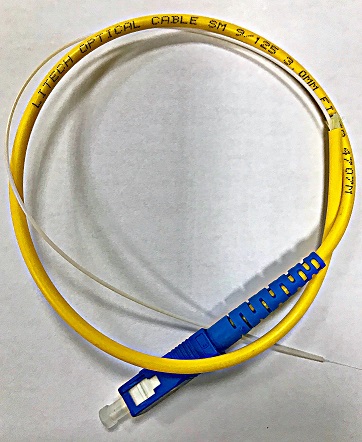Network medium
Depending on whether it is a physical medium (cable) or a wave-based communication (wireless), mainly the following networking mediums for data transferring and communication are used:
- Metallic mediums, copper wires in twisted pairs and coaxial cables transmit electrical impulses
- Glass mediums, fibre optic cable transmit pulses of light
- Air mediums, waves and rays from the electromagnetic spectrum transmit signals in different frequencies
Note
You can learn more about computer network mediums at https://www.techwalla.com/articles/types-of-media-used-in-computer-networking.
Twisted pairs
Twisted pairs, as in Figure 1.23, is a cable that contains four twisted pairs of copper; a total of eight wires, each with a specified color. The single wires are twisted around each other forming twisted pairs, and then the pairs are twisted around each other forming the cable; and that is done to reduce electromagnetic interference (EMI) and cross-talk. Usually, it is available in two types: unshielded twisted pair (UTP), and shielded twisted pair (STP). Mainly, it is used for designing LANs. The maximum distance that the twisted pairs medium can successfully carry a signal in an Ethernet network is 100 m.

Figure 1.23. UTP cable
Coaxial
Coaxial, as in Figure 1.24, is a copper cable presented in two forms: thin coaxial, with a length up to 185 m; and thick coaxial, with a length up to 500 m. In the past, it was used to implement computer networks with the bus and ring physical topologies. Nowadays, it is mainly used by cableInternet Service Providers (ISP) for transferring data and video signal:

Figure 1.24. Coaxial cable
Fibre optic
Fibreoptic, as in Figure 1.25, is a cable made up of glass through which the light is transmitted. Based on the light transmission, it is offered in two modes:
- Single mode utilizes only one light, and can reach a length from 40 km to 60 km
- Multimode utilizes multiple lights, and can reach a length from 2 km to 3 km.
Apart from its traditional usage in WANs, today fibre optic is used a lot for the implementation of fiber to the home (FTTH), and MAN networks:

Figure 1.25. Fibre optic cable
Infrared and Bluetooth
Infrared and Bluetooth are wireless technologies for transmission of data over short distances. Infrared, as the name explains, uses infrared rays, and requires the line of sight to transmit the infrared signal. On the contrary, Bluetooth operates under 2.4 GHz frequency standard, and it does not suffer from the line of sight communication.
Radio waves
Radio waves, otherwise known as electromagnetic radiation, uses electromagnetic waves with a longer spectrum of wavelengths than infrared rays. Since they operate on different frequencies, hence, it makes it possible to cover large areas. Radio waves have found application in WAN's.
Satellite
Whereever the infrared, Bluetooth and radio waves cannot reach the destination, it will be reached by satellite signals. Unlike aforementioned wireless technologies, satellite technology uses a wide spectrum of wavelengths and frequencies. Today, it is estimated that there are more than 2,000 satellites in Earth's orbit that enable telecommunications around the globe.





































































